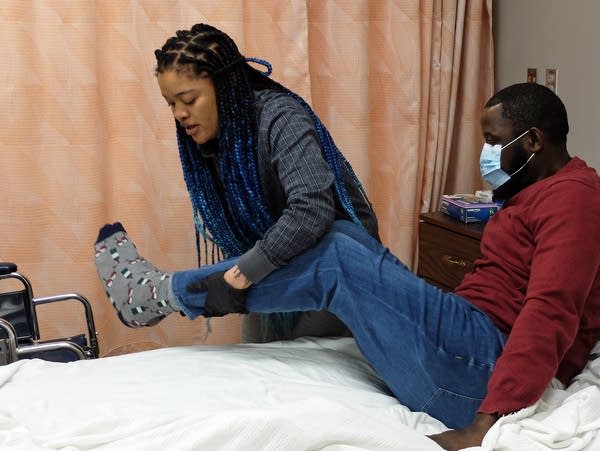The quality, cost and future of long-term care in Minnesota

Go Deeper.
Create an account or log in to save stories.
Like this?
Thanks for liking this story! We have added it to a list of your favorite stories.
Long-term care facilities were ground zero for COVID-19 deaths early in the pandemic. Then, residents struggled with profound isolation after family members and friends were banned or discouraged from visiting to keep out the virus.
Now there’s a new crisis facing long-term care. Overwhelmed by long hours, low pay and COVID exposure, people who work in long-term care facilities are quitting their jobs in record numbers. As the pandemic stretches into a third year, the chronic staffing problem in nursing homes and assisted living facilities has intensified. As of this fall, three quarters of long-term care facilities in Minnesota were limiting admissions.
Gov. Tim Walz responded to the labor shortage by sending National Guard nursing teams to struggling facilities and promising to train more certified nursing assistants. Last week, President Joe Biden released a list of proposals to improve long-term care, including a call for minimum staffing levels. Many nursing home operators are wondering where they’ll find workers.
MPR News host Angela Davis spoke with long-term care experts about the quality, cost and future of long-term care in Minnesota.
Turn Up Your Support
MPR News helps you turn down the noise and build shared understanding. Turn up your support for this public resource and keep trusted journalism accessible to all.
Guests:
Rajean Moone is the faculty director for long-term care administration in the College of Continuing and Professional Studies at the University of Minnesota. He also serves as associate director of education for the Center for Healthy Aging and Innovation in the School of Public Health.
Aisha Elmquist is deputy ombudsman for long-term care for the state of Minnesota, a program of the Minnesota Board on Aging. The ombudsman office has representatives around the state and acts as an advocate for the health, safety and rights of long-term care consumers. For more information or to raise a concern or complaint visit www.mn.gov/ooltc.
Subscribe to the MPR News with Angela Davis podcast on: Apple Podcasts, Google Podcasts, Spotify or RSS.
Hear their conversation using the audio player above and read the highlights below.
There are more than 23,000 care positions vacant in Minnesota, said Rajean Moone, an expert in long-term care administration at the University of Minnesota. “This is all hands on deck. If you work in a nursing home, you may be an accountant, but some days, you may also be working in the kitchen serving food.”
“Since the pandemic, it is worsened considerably,” said Aisha Elmquist, Minnesota’s deputy ombudsman for long-term care. At one facility, Elmquist said that one day residents were served only peanut butter sandwiches for lunch, with no breakfast or dinner.
She called it an “extreme example” — but one that reflects a trend her office now sees with lack of proper staffing.
“These are vulnerable adults, and somebody has to have a voice for them, and it has to be us,” said Barbara, a registered nurse and caller from St. Louis Park. She said that to encourage health workers to stay in the long-term care profession, they should be paid like professionals.
“According to the most recent numbers from the Bureau of Labor Statistics, we're looking at about $14 an hour for a certified nursing assistant in a nursing home,” said Moone. “A certified nursing assistant in another health care setting would make significantly more than that.”
When understaffed facilities close, residents and their families can find themselves stuck. Jacob, a caller from St. Paul, said his family had recently been notified that the long-term care facility where his disabled sister lives, would soon be forced to close. He said she would end up in a crisis care center. “We don’t have any other options for her,” he said.
For others, the cost of long-term care is enormous, and families might pay tens of thousands or more than $100,000 in a year, for a resident to live in a private room with access to 24-hour skilled care. Those who depend on Medicaid waivers have more limited options, Elmquist said.
In Minneapolis, Beth called in to share her experiences from coordinating staffing at a local nursing home. “It’s chaos,” she said. “Every day people leave the floor openly weeping. This was 2018. This was pre-COVID. We needed the National Guard in 2018.”


